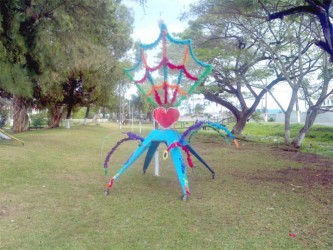By Desilon Daniels
Throughout Mashramani day, floats followed by revellers proceed through the streets, entertaining as they go. However, after the celebrations of the day are finished, what becomes of these floats?
An immense amount of time, energy and money is put into the creation of floats and costumes for each represented organisation. Volda Ramsammy, designer for the Ministry of Culture, Youth and Sport’s costume and teacher at the ER Burrowes School of Art, explained that it had taken about three weeks for her team to design the costumes.
For this, the ministry earned second place in the full costume – large bands category and the prize for the best non-commercial semi-costume.

According to Ramsammy, the float was created through the collaborative efforts of the students and staff of the Burrowes School of Art, the National Dance School as well as other governmental cultural groups.
Over the years, the team had worked well into the nights on their creations, sometimes even spending the night to complete their work. Though Ramsammy said that they had been fortunate this year and had not been forced to “sleep in,” it had still been a strenuous job.
“I feel a sense of pride every year when the ministry brings out a theme and we always manage to stick to it,” she said.
The float was created using a number of materials, including fibre glass rod, foam, and cloth. Most of the materials used, Ramsammy said, were found in Guyana. However, some of them had to be imported. “It’s difficult to find suitable materials for costumes,” she lamented. “In many cases we had been forced to substitute some materials for others.”
Even though they had been on a strict budget set by the ministry, Ramsammy said the process was still an expensive one. She estimated the total cost of producing the floats and costumes at over $3 million.
The art school elected to dismantle its floats, recycling its materials for future use.
Though some organisations may choose to dispose of their floats properly, others have instead dumped them around the city, seeming to forget the hours and money spent on their designs. Some of the floats did not even make it beyond the National Park.
“On a personal level, I think the country as a whole needs to stop wasting its resources,” Ramsammy said.
Lennox Canterbury, Coordinator of the Mash Secretariat, explained that the secretariat was not responsible for the floats after they’ve completed the registration and voting processes. The floats, he said, are the responsibilities of the respective bands. However, he stated that he would often encourage bands to keep their floats and costumes for posterity.

Some of the bands, including the Ministry of Culture, Youth and Sport, will be participating in either Linden’s or Berbice’s Mashramani celebrations tomorrow. According to Ramsammy, the costumes created by the art school have already been washed and prepared for Linden’s Mash.
Canterbury clarified that the Regional Mash Committees for regions 10 and 12 were responsible for this weekend’s festivities, not the Mash Secretariat. According to him, the committees have an open door policy with all of Georgetown’s participants being invited to take part in Linden and Berbice’s revelries.




